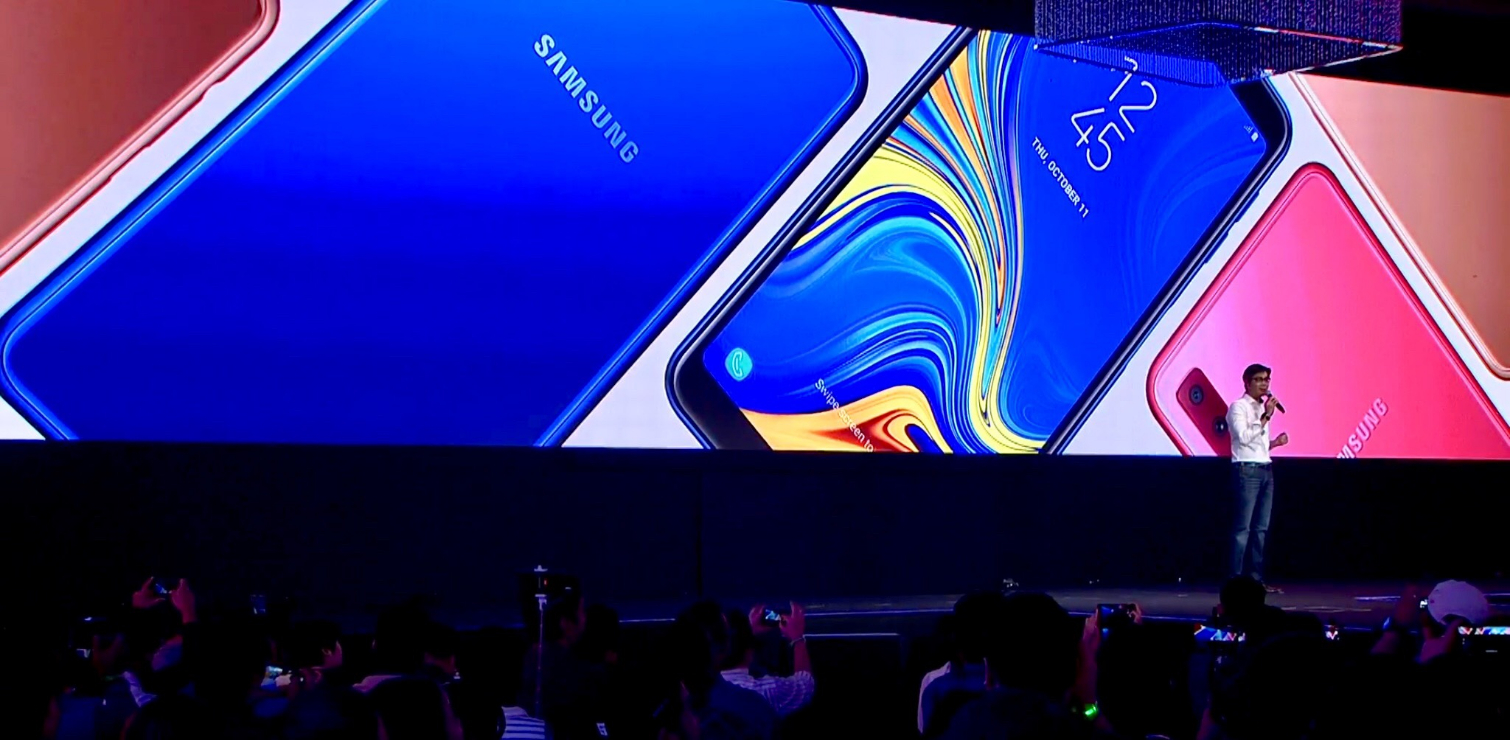The Galaxy A9 Is the World’s First Quad-Camera Phone
Samsung is putting the company’s “latest innovations” in the its newest phones, even if they're not flagships.
Samsung has unveiled its new Galaxy A7 and A9 phones, and the Galaxy A9 does indeed have four cameras, the world’s first phone to claim that absurd record. It seems like a better phone than the Galaxy S9, with better camera performance according to Samsung itself.

How can a cheaper phone have better features than a flagship? Talking at the Galaxy A9 and A7 presentation in Kuala Lumpur, Malaysia, Samsung’s CEO DJ Koh declared that the company’s new strategy is not to wait for the flagships to roll out the latest and best technology anymore, but to deploy new features as they invent them in whatever phone comes next in the release timeline.
The A9’s quad-sensor camera and the power-on fingerprint reader is a good example of that. Allegedly, this thing will take much better pictures than your Galaxy S9 and Note 9, which all of the sudden look a bit tired.
Galaxy A9 and A7 Pricing and Availability
The Galaxy A7 is available to order now, while the Galaxy A9 will be available in November. The A7 starts at €350 or about $400, while the A9 will cost €599 or $690.
Quad Cameras
To get its special photographic powers, the Galaxy A9 comes with a dedicated sensor and lenses to cover what Samsung believes are the potential photo scenarios that any user can face: a 24-megapixel main camera, a 100MP telephoto, an 8-MP ultra wide camera, and 5-MP depth camera.
Get instant access to breaking news, the hottest reviews, great deals and helpful tips.
Samsung claims that its 240MP camera is “extremely sensitive” to light, using a technique that merges four pixels in the sensor into one to be able to capture more light. It also claims that this capability can adjust dynamically depending on how the photo is lighted, capturing finer details on the brighter parts of the photo. We will have to see how this really works in real life.

The sensors are all controlled by artificial intelligence software, like in the iPhone XS, the Huawei P20 Pro or the Google Pixel 3. A new “scene recognizer” will automatically optimize the image capturing to get the best shot.
The A9 also uses AI to warn you if someone has blinked, which seems rather pedestrian when you compare it to Google’s Top Photo mode that takes several photos in burst mode to pick the best for you.
MORE: Samsung Galaxy S10 Rumors: Specs, Release Date and More
Samsung says that the wide-angle lens 8-MP sensor can cover 120 degrees of your field of view, just like the human eye, compared to the typical 77-degree field of view of regular phone cameras. The 120-degree mode gets activated when you click a special ultra-wide mode button on the camera interface. Samsung didn’t say if the phone’s AI combines the regular sensor and the ultra-wide sensor for higher resolution.
The ultra-wide sensor also applies to a new panorama mode that results in extremely large photos, expanding the field of view on the top and bottom of the panorama.
The telephoto lens provides 2X optical zoom, while using the depth camera is for depth of field effects. On the front, there's the same 24 megapixel camera that's on the back.
Design and Specs
The A9 has an aluminum body that comes in three colors, a shiny all-black called Caviar Black” and two gradient colors: Lemonade Blue and Bubblegum Pink. Samsung claims it had to invent a new coloring process to get the gradient, which dips the phone slowly in and out of the dye.

By default, the A9 comes with 128GB of internal storage, with the option to expand it with a 512GB card for a total of 640GB storage which, as Samsung pointed out on stage, is more than most laptops.
The A9 comes with a 3,800mAh battery and fast charging support. For security, the phone has face recognition or you can use the fingerprint scanner on the back.
MORE: Best Smartphone Camera - Phones With the Best Quality
Galaxy A7
The Samsung Galaxy A7 doesn’t have the fingerprint scanner on the back. It comes with a new feature that puts the fingerprint scanner on the power button itself, which is quite clever.
Unlike the A9, the A7 has an all-glass body that comes in blue, black, gold and pink that, according to the company, is so vibrant because it features an optical effect pattern etched deep under the glass.

The A7 has one less sensor than the A9. On the back there is a triple camera — “for the generation Instagram,” as Samsung cringely calls it — with a 24-megapixel main sensor, the same depth camera that combines with the main one to add DSLR-like depth of field effects, and the wide lens camera. Again like in the A9, this wide angle view is activated in the camera software.
MORE: 10 Cheap Android Smartphones (Under $250) Ranked Best to Worst
Also like the A9, the A7’s selfie camera is exactly the same sensor as the main camera on the back.

The cameras were truly the focus of this presentation. Samsung seems pretty bullish about its capabilities, but we will have to test both phones to see how they compare to the Huawei, the iPhone XS, and the Pixel 3 to see how good they truly are.
Photo Credits: Samsung
Jesus Diaz founded the new Sploid for Gawker Media after seven years working at Gizmodo, where he helmed the lost-in-a-bar iPhone 4 story and wrote old angry man rants, among other things. He's a creative director, screenwriter, and producer at The Magic Sauce, and currently writes for Fast Company and Tom's Guide.
-
Zoolook13 How can you call fingerprint sensor in the power button "new" ? Sony had it for ages, and yes it is the best place to put it, really stupid of Sony to move it.Reply

